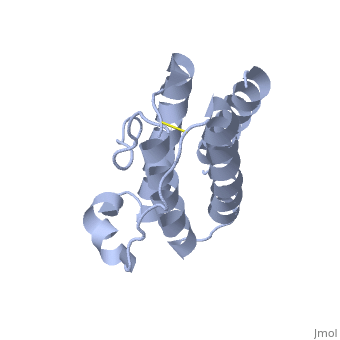User:Mary Ball/Leptin
From Proteopedia
| |||||||||
| Human obesity protein leptin-E100 1ax8 | |||||||||
|---|---|---|---|---|---|---|---|---|---|
| Gene: | OBESE GENE (Homo sapiens) | ||||||||
| |||||||||
| |||||||||
| Resources: | FirstGlance, OCA, RCSB, PDBsum | ||||||||
| Coordinates: | save as pdb, mmCIF, xml | ||||||||
Contents |
HUMAN OBESITY PROTEIN, LEPTIN
Mutations in the obese gene (OB) or in the gene encoding the OB receptor(OB-R) result in obesity, infertility and diabetes in a variety of mouse phenotypes. The demonstration that OB protein (also known as leptin) can normalize body weight in ob/ob mice has generated enormous interest. Most human obesity does not appear to result from a mutant form of leptin: rather, serum leptin concentrations are increased and there is an apparent inability to transport it to the central nervous system (CNS). Injection of leptin into the CNS of overfed rodents resistant to peripheral administration was found to induce biological activity. Consequently, for the leptin to act as a weight-lowering hormone in human obesity, it appears that appropriate concentrations must be present in the CNS. This places a premium on understanding the structure of the hormone in order to design more potent and selective agonists.
Quiz
Additional Reading
- "Gimmick-Free Weight-Loss Pill in the Works", January 2010 article from Science Daily News.
- Article on the Discovery of Leptin from the Howard Hughes Medical Institute.
Mutations in the obese gene (OB) or in the gene encoding the OB receptor(OB-R) result in obesity, infertility and diabetes in a variety of mouse phenotypes. The demonstration that OB protein (also known as leptin) can normalize body weight in ob/ob mice has generated enormous interest. Most human obesity does not appear to result from a mutant form of leptin: rather, serum leptin concentrations are increased and there is an apparent inability to transport it to the central nervous system (CNS). Injection of leptin into the CNS of overfed rodents resistant to peripheral administration was found to induce biological activity. Consequently, for the leptin to act as a weight-lowering hormone in human obesity, it appears that appropriate concentrations must be present in the CNS. This places a premium on understanding the structure of the hormone in order to design more potent and selective agonists. Here we report the crystal structure at 2.4A resolution of a human mutant OB protein (leptin-E100) that has comparable biological activity to wild type but which crystallizes more readily. The structure reveals a four-helix bundle similar to that of the long-chain helical cytokine family.
Crystal structure of the obese protein leptin-E100., Zhang F, Basinski MB, Beals JM, Briggs SL, Churgay LM, Clawson DK, DiMarchi RD, Furman TC, Hale JE, Hsiung HM, Schoner BE, Smith DP, Zhang XY, Wery JP, Schevitz RW, Nature. 1997 May 8;387(6629):206-9. PMID:9144295
From MEDLINE®/PubMed®, a database of the U.S. National Library of Medicine.
About this Structure
1AX8 is a 1 chain structure of sequence from Homo sapiens.
3D structures of leptin
Updated on 19-August-2014
1ax8 - Leptin (mutant) - human
Reference
- Zhang F, Basinski MB, Beals JM, Briggs SL, Churgay LM, Clawson DK, DiMarchi RD, Furman TC, Hale JE, Hsiung HM, Schoner BE, Smith DP, Zhang XY, Wery JP, Schevitz RW. Crystal structure of the obese protein leptin-E100. Nature. 1997 May 8;387(6629):206-9. PMID:9144295 doi:10.1038/387206a0


